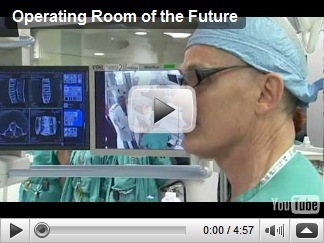This is fascinating to watch how the imaging works right in the OR. Cross sectional images are no problem. The video states they have two units, but the updated  article here states they have 3 more of the Siemens Artis Zeego units. When you watch the video it is pretty mind blowing to watch the “claw” looking type arm just to be able to revolve around and be where it needs to be placed.
article here states they have 3 more of the Siemens Artis Zeego units. When you watch the video it is pretty mind blowing to watch the “claw” looking type arm just to be able to revolve around and be where it needs to be placed.
As a patient you do not have to be wheeled into another department for imaging and this is a real plus for interventional procedures. When you see the OR in the video there’s a lot of high tech equipment in there. The one neurology surgeon talks about the entire concept of their “surgery room of the future”. With using high tech the one surgeon says it is re-defining what a surgical specialist is and the skills needed, such as being an information technology expert, a radiologist, be able to do minimally invasive procedures, and do conventional surgeries and more.
Interventional surgery is merging with imaging in short. It starts with the electronic medical records with everyone having access, the anesthesiologists, the nurses, and so on.
It does look like one big “claw” coming at you. It revolves around as you can see in the image below.
The one surgeon talks about how the average patient is now older, more fragile, thus minimally invasive surgical procedures and time saving efficiencies are improving outcomes and pain too. The image below shows that a patient can be sitting in an wheel chair and be imaged.
Dr. Oz used to operate at New York Presbyterian, although with his new show and career I don’t know how much time he has today in the OR. The hospital also connects patient records with HealthVault for the patient side of things.
Dr. Oz Talks About Healthcare Reform with a “Clinical” and “Smart Patient” View
It definitely gives the hospital an edge on angiograms. Also mentioned is the software that helps with the guidance of needle/catheter positioning so it is right on target, and that we all want. This is part of the new operating room, the big C Claw that moves around the patient instead of having to move the patient. BD
In a move that could change the way many patients undergo surgery, NewYork-Presbyterian Hospital has installed five state-of-the-art Siemens Artis
zeego® medical imaging systems that provide faster, more accurate 3-D images of the body with a quality never before attainable. With more complete information, surgeons can better assess a patient's condition, devise a detailed surgical plan, and provide more targeted surgical treatment.
According to NewYork-Presbyterian surgeons, the radiographic imaging technology promises to transform the care of patients, with improved safety and outcomes, while stimulating innovation. The Artis zeego's robotic C-arm "senses" the location of the operating table, giving surgeons extraordinary flexibility to maneuver the imaging system at almost every angle without moving the patient. As a result, internal organs can be seen from a "fly around" perspective in three dimensions, in minute detail.
"This technology is a major step forward. Previously, to obtain such images, we had to bring patients to a separate radiology suite. Now, high-quality imaging is available right in the operating room, giving us an amazingly clear picture of the patient's anatomy from any angle. This helps us ensure the highest quality of care," says Dr. Jeffrey Milsom, executive director of the Center for Advanced Digestive Care and chief of Colon and Rectal Surgery at NewYork-Presbyterian Hospital/Weill Cornell Medical Center and the Jerome J. DeCosse, M.D., Professor of Surgery at Weill Cornell Medical College. "Going forward, image procurement and analysis in the operating room will open up new avenues for minimally invasive surgical innovation and improved
patient outcomes."
"Oftentimes the best approach for a patient involves a combination of coronary artery bypass and stenting. By performing both at the same time, we are not only making it more convenient, but we are reducing the stress of surgery and improving recovery time."
The imaging technology can also be used after a standard bypass to ensure the bypass graft is providing adequate blood flow to the heart. Published research has shown that this approach can reduce the number of complications.
Operating room radiography to transform surgery






This machine is awesome! thanks for sharing this great info about it!
ReplyDeleteIt is too awesome post! very nice to read that Operating Room With 3D!!
ReplyDelete